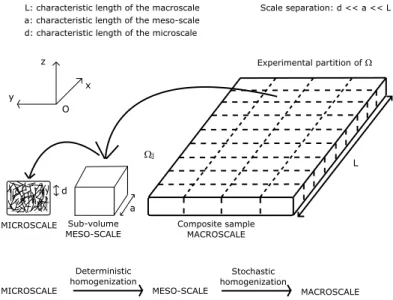HAL Id: hal-00698977
https://hal-upec-upem.archives-ouvertes.fr/hal-00698977
Submitted on 18 May 2012
HAL is a multi-disciplinary open access
archive for the deposit and dissemination of
sci-entific research documents, whether they are
pub-lished or not. The documents may come from
teaching and research institutions in France or
abroad, or from public or private research centers.
L’archive ouverte pluridisciplinaire HAL, est
destinée au dépôt et à la diffusion de documents
scientifiques de niveau recherche, publiés ou non,
émanant des établissements d’enseignement et de
recherche français ou étrangers, des laboratoires
publics ou privés.
On modelling reinforced composites exhibiting
stochastic fluctuations on volume fraction: a stochastic
micromechanical approach
J. Guilleminot, Christian Soize, D. Kondo, C. Binetruy
To cite this version:
J. Guilleminot, Christian Soize, D. Kondo, C. Binetruy. On modelling reinforced composites
exhibit-ing stochastic fluctuations on volume fraction: a stochastic micromechanical approach. XXII ICTAM,
International Congress of Theoretical and Applied Mechanics, School of Mathematical Sciences,
Uni-versity of Adelaide„ Aug 2008, Adelaide, Australia. pp.1-2. �hal-00698977�
XXII ICTAM, 25–29 August 2008, Adelaide, Australia
ON MODELLING REINFORCED COMPOSITES EXHIBITING STOCHASTIC UNCERTAINTIES
ON VOLUME FRACTION: A STOCHASTIC MICROMECHANICAL APPROACH
Johann Guilleminot
∗, Christian Soize
∗∗, Djimedo Kondo
∗∗∗& Christophe Binetruy
∗∗
Ecole des Mines de Douai, Department of Polymers and Composites Technology & Mechanical Engineering,
941 rue Charles Bourseul, BP 10838, 59508 Douai Cedex, France
∗∗
Université Paris-Est, Laboratoire de Mecanique, 5 bd Descartes, 77454 Marne-la-Vallee, France
∗∗∗Université des Sciences et Technologies de Lille, Laboratoire de Mécanique de Lille-UMR CNRS 8107,
Cité Scientifique, Bd. Paul Langevin, 59655 Villeneuve d’Ascq Cedex, France
Summary The study deals with the characterization of the random fluctuations of volume fraction and its impact on the overall stochastic properties in reinforced composites. A relevant probabilistic model as well as the associated stochastic solver are presented. An original experimental procedure, relying on a non-destructive ultrasonic method, is introduced and allows the parameters involved in the stochastic modelling to be determined. It is seen that the volume fraction can be modelled by a homogeneous random field whose spatial correlation lengths are determined and may provide conditions on the size of the meso-volumes to be considered.
SHORT PAPER
Many engineering materials exhibit fluctuations and uncertainties on their macroscopic mechanical properties. This ba-sically results from random fluctuations observed at a lower scale (especially at the mesoscale where microstructural uncertainties generally occur) and is mainly due, dealing with composite materials, to the randomness of the manufactur-ing process.
The main objective of this study is twofold:
(i) first, the paper aims at characterizing volume fraction stochastic fluctuations in fiber reinforced composites, (ii) then, the impact of such randomness on the effective mechanical stochastic properties is investigated.
For this purpose, a complete theoretical stochastic framework and the associated experimental investigation are proposed and applied to a long fiber thermoplastic. First, relevant scales are introduced, allowing one to proceed to two successive homogenizations taking into account the random mesostructure of the composite, as shown on Fig. (1).
Then, considering the nature of the fluctuations, the volume fraction at the microscale is modelled as a random field and
Figure 1. Top: experimental partition and scale separation. Bottom: successive homogenization procedures.
the construction of a suitable probabilistic model is proposed. More precisely, a statistical reduction of the random field is performed using a Karhunen-Loeve expansion and the probabilistic interpolation of the random vector involved in the representation is carried out using a Polynomial Gaussian Chaos expansion. The identification of the Chaos coefficients is classically performed using the Maximum Likelihood Principle, leading to a high-dimensional optimization problem solved by a random search.
The random effective properties are further represented using a Polynomial Gaussian Chaos expansion whose coefficients are determined coupling the double-scale homogenization procedure with a non-intrusive stochastic solver. An experi-mental procedure dedicated to the identification of the parameters involved in the probabilistic model is presented and relies on velocity measurements (using a non-destructive ultrasonic method). The combination of these experimental results with a micromechanical analysis (see Fig. (2)) basically provides realizations of the volume fraction random field (see Fig. (3)).
Figure 2. Micromechanics-based mapping between the wave velocity and volume fraction.
Figure 3. Left: Volume fraction random field, experimental realization 5. Right: Meshed representation of the empirical correlation
matrix.
In particular, it is seen that the volume fraction can be modelled by a homogeneous random field whose spatial correlation lengths are determined and may provide conditions on the size of the meso-volumes to be considered.
References
[1] Desceliers, C., Ghanem, R., Soize, C. "Maximum likelihood estimation of stochastic chaos representations from experimental data", Int. J. Numer. Meth. Engng, 66, pp.978-1001, 2006.
[2] Loève, M., "Probability Theory, 4th Ed.", Springer Verlag, New-York, 1977.
[3] Soize, C., Ghanem, R., "Physical systems with random uncertainties: Chaos representations with arbitrary probability measure", SIAM Journal on Scientific Computing, 26 (2), pp.395-410, 2004.

